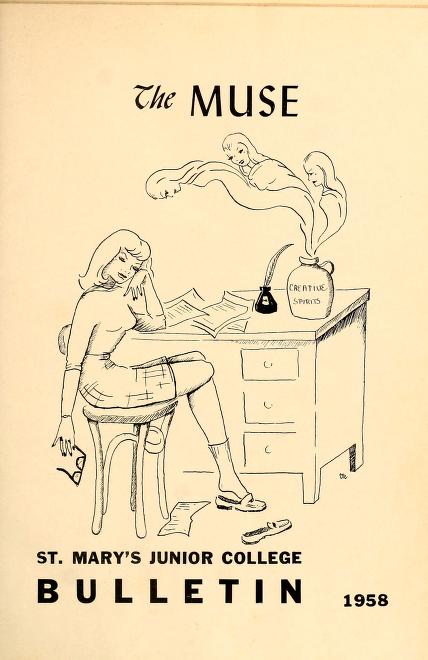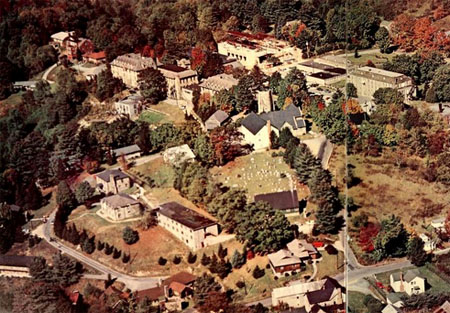 More than 1,000 early issues of The Chatham Record, a weekly newspaper published in Pittsboro, are now available in the North Carolina Newspapers digital collection. The papers cover the years 1879 to 1901, a crucial period in North Carolina history as the state emerged from war and reconstruction and engaged in fierce political battles that would resonate throughout the twentieth century.
More than 1,000 early issues of The Chatham Record, a weekly newspaper published in Pittsboro, are now available in the North Carolina Newspapers digital collection. The papers cover the years 1879 to 1901, a crucial period in North Carolina history as the state emerged from war and reconstruction and engaged in fierce political battles that would resonate throughout the twentieth century.
Saint Mary’s School Literary Journals and Bulletins Available Online


Early Issues of the Asheboro Courier Now Available Online
Early issues of the Asheboro Courier are now available in the North Carolina Newspapers digital collection. More than 500 issues, ranging from 1884 to 1912, have been digitized. The Courier was one of the first newspapers to be published in Asheboro, tracing its origins back to 1876. Unfortunately, few early issues are available.
Summer 2012 Newsletter Now Online!
Read about recent activities at the North Carolina Digital Heritage Center, including highlights from the newspaper collection, featured projects, and more in the Summer 2012 newsletter, now available online.
North Carolina Digital Heritage Center Reaches 100 Partners!
With the recent addition of student yearbooks from Lees-McRae College, we are very pleased to announce the North Carolina Digital Heritage Center has now worked with 100 different institutions. These 100 content partners have contributed an incredible variety of materials related to the history and culture of North Carolina, all of which is easily and freely accessible at DigitalNC.org.
Our partners are spread across the state, from Western Carolina University and the Haywood County Public Library in the west, to Elizabeth City State University and the Wilmington Railroad Museum in the east. The biggest concentration is in and around the cities in the Piedmont, with eight of our partners located in Guilford County and seven each in Mecklenburg and Forsyth Counties.
Lees-McRae College Yearbooks Now Available on DigitalNC
Student yearbooks from Lees-McRae College are now available in the North Carolina Yearbooks collection on DigitalNC.org. The Lees-McRae “campus in the clouds” is located in Banner Elk, N.C., and is now home to around 900 students. The college traces its origins to 1899, when it began as a boarding school for young women in the area.
Early Pinehurst Newspaper Now Available Online
 Over 500 issues of The Pinehurst Outlook, a weekly paper that began publication in 1897, are now available online in the North Carolina Newspapers collection.
Over 500 issues of The Pinehurst Outlook, a weekly paper that began publication in 1897, are now available online in the North Carolina Newspapers collection.
“Pinehurst, the famous winter resort owned by Mr. James Tufts of Boston, Mass., is a village of fifty houses, elegantly furnished hotels, boarding houses, public casino, fine hall for church services and entertainments, school house, museum, library, deer park, stores, bowling alley, and 18-hole golf links the finest in the South.”
Earliest Asheville Newspaper Now Available On DigitalNC
 Early issues of the Highland Messenger, the first newspaper to be published in Asheville, are now available in the North Carolina Newspapers project. The Messenger began publication in 1840, when there were just a few thousand people living in Buncombe County. The initial goals of the paper were quite lofty. Here they are, as stated in the first issue:
Early issues of the Highland Messenger, the first newspaper to be published in Asheville, are now available in the North Carolina Newspapers project. The Messenger began publication in 1840, when there were just a few thousand people living in Buncombe County. The initial goals of the paper were quite lofty. Here they are, as stated in the first issue:
“Our paper shall be devoted to Religion, Morality, Science, Politics and General Intelligence, having for its leading object the instruction and advantage of the people, wherever it shall be attentively read.”
Like most papers published in this period, much of the content relates to national news and politics interspersed with a wide variety of features and short pieces, with little space given to local reports. However, it is possible, through the many advertisements, court notices, letters, and editorials to get a sense of the issues and concerns of the village that would, by the early 20th century, grow into what another paper would come to call the “mountain metropolis.”
Historic Issues of the Goldsboro Highlight Now Available on DigitalNC
 Historic issues of the Goldsboro Headlight from 1887 to 1903 are now available in the North Carolina Newspapers collection. Advertised as a “first class Democratic family newspaper,” the Headlight was published weekly and was typical of the newspapers of the time in that it included a little local news and politics, a regular column reporting on social activities in the town, and a lot of features and illustrations borrowed from other publications around the country.
Historic issues of the Goldsboro Headlight from 1887 to 1903 are now available in the North Carolina Newspapers collection. Advertised as a “first class Democratic family newspaper,” the Headlight was published weekly and was typical of the newspapers of the time in that it included a little local news and politics, a regular column reporting on social activities in the town, and a lot of features and illustrations borrowed from other publications around the country.
North Carolina Whig, Charlotte Newspaper from 1850s and 1860s, Now Available Online
The North Carolina Whig, a newspaper published in Charlotte in the 1850s and 1860s, is now available on DigitalNC as part of the North Carolina Newspapers collection.
 The Whig began publication on January 26, 1852, declaring in its first issue support for the Presidential ticket of incumbent Millard Fillmore for President and North Carolinian William A. Graham as Vice President. The editors confess their inexperience and ask for patience from readers and critics: “And, as this is our first adventure in an enterprise of this nature as helmsman, we ask that the storms of criticism and party spirit may lie still, until we have cleared the rocks and reefs of the port from whence we sail. Our freight is Truth, Justice, Honesty, Patriotism, Good Faith, the Rights of the Constitution, and of the People, as developed in the administration of Millard Fillmore.”
The Whig began publication on January 26, 1852, declaring in its first issue support for the Presidential ticket of incumbent Millard Fillmore for President and North Carolinian William A. Graham as Vice President. The editors confess their inexperience and ask for patience from readers and critics: “And, as this is our first adventure in an enterprise of this nature as helmsman, we ask that the storms of criticism and party spirit may lie still, until we have cleared the rocks and reefs of the port from whence we sail. Our freight is Truth, Justice, Honesty, Patriotism, Good Faith, the Rights of the Constitution, and of the People, as developed in the administration of Millard Fillmore.”
About
This blog is maintained by the staff of the North Carolina Digital Heritage Center and features the latest news and highlights from the collections at DigitalNC, an online library of primary sources from organizations across North Carolina.


